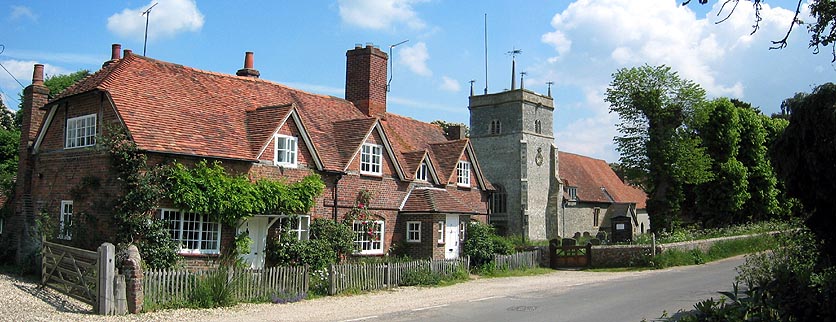 |
 |
|||
|
|
Bucklebury Royalists & Rows of Oaks
Bucklebury House was a grange belonging to Reading Abbey. At the dissolution, the King sold it to John Winchcombe, son of the famous clothier, Jack O’Newbury. He built a splendid Tudor mansion here with a fine long gallery, where he entertained Elizabeth I. Only one wing now remains, since a fire in 1833. Medieval fishponds stand nearby. The Winchcombes remained catholic even after the reformation, but one of the young lords was converted to Protestantism by Archbishop Laud while at Oxford. The family heiress was Frances Winchcombe, the wife of the infamous Henry St. John, Viscount Bolingbroke. He was sometime leader of the Tory Party who, fearing their demise with the fall of the House of Stuart, almost managed to repeal the Act of Settlement favouring the Hanovarian succession. Queen Anne, however, died too soon for his plans to be concluded. He retired to Bucklebury for a while but was attainted and forced to flee abroad. He cruelly neglected his poor wife who remained in Berkshire while he joined the Court of the so-called James III in Paris. Leaving the service of the Old Pretender just prior to Frances’ death, he became a writer of some repute, returning to England at his pardon in 1723. He was a great influence on his contemporaries, but has unfortunately been lost among the pages of history. The church has one of the best Norman doorways in the county and also strange carvings high up on the tower, including a man with an adze and a wheel. It has been suggested that this is a rather obscure rebus playing on the name Winchcombe: a man combing a winch. Inside there is a fine array of hatchments, though the Winchcombe funerary helms have now been removed. The most fascinating fitting is the extremely life-like fly painted on a 17th century sundial window in the Winchcombe pew, reminding us how quickly Time Flies. The vicar during the Civil War was one Guy Carleton (later Bishop of Chichester). Like the Lord of the Manor, he was a staunch Royalist and was thus imprisoned in Lambeth Palace. However, he escaped out of a window and fled abroad. The Earl of Manchester and his parliamentary army of some 20,000 men camped on the western end of Bucklebury Common on 25th October 1644, just prior to the Second Battle of Newbury. There was also some sort of local skirmish in the Spring of that year at the Forties just south of the Blade Bone Inn. Soldiers of the King slain at Chapel Row are recorded as being buried in the churchyard, along with Lieut. Richard Warde, a parliamentary officer. The double avenue of oak trees on the Common commemorate visits by two reigning Queens: Elizabeth I (as above) & Queen Anne. The supporters of the 1830 Machine Riots of West Berkshire marched through Bucklebury, burning hay ricks and smashing several farming machines. Chapel Row in the parish was once famous for its revels which took place every St. Anne's Day. Nearby Ironmongers Copse has an unusual name. It has nothing to do with the local scrap-metal merchant, but is named after the Iremonger family who were yeomen farmers in Bucklebury and Beenham for over two hundred years. Margaret Iremonger’s baptism, in 1538, is the first recorded in the Bucklebury parish registers.
|
|||
| © Nash Ford Publishing 2001. All Rights Reserved. | ||||



